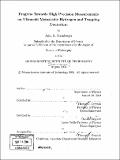Progress towards high precision measurements on ultracold metastable hydrogen and trapping deuterium
Author(s)
Steinberger, Julia K., 1974-
DownloadFull printable version (9.088Mb)
Other Contributors
Massachusetts Institute of Technology. Dept. of Physics.
Advisor
Thomas J. Greytak and Daniel Kleppner.
Terms of use
Metadata
Show full item recordAbstract
(cont.) not achieve deuterium trapping through helium-surface cooling. It is proposed that buffer gas loading can be used to cryogenically cool and trap deuterium. Ultracold metastable trapped hydrogen can be used for precision measurements for comparison with QED calculations. In particular, Karshenboim and Ivanov [Eur. Phys. Jour. D 19, 13 (2002)] have proposed comparing the ground and first excited state hyperfine splittings of hydrogen as a high precision test of QED. An experiment to measure the 2S hyperfine splitting using a field-independent transition frequency in the 2S manifold of hydrogen is described. The relation between the transition frequency and the hyperfine splitting requires incorporating relativistic and bound state QED corrections to the electron and proton g-factors in the Breit-Rabi formula. Experimental methods for measuring the magnetic field of an ultracold hydrogen sample are developed for trap fields from 0 to 900 G. The temperature of the trapped sample at the field-independent point is a critical parameter, and is inferred from the IS - 2S lineshape. The detailed dependence of this lineshape on the trap geometry is examined. A search for the transition was undertaken, but no signal was observed. The systematics of the experiment are analyzed, and modifications for carrying out the experiment are proposed. In a separate study, the possibilities for trapping (never previously trapped) deuterium in the same cryogenic cell and magnetic trap used to trap hydrogen were investigated. Deuterium's behavior on a helium surface differs markedly from that of hydrogen due to its larger surface binding energy. We carried out a variety of studies of both hydrogen and deuterium during the trap-loading stage, working with both ⁴He and ³He surfaces. Introducing ³He in the cell decreases the surface binding energy of deuterium, and thus the rate of recombination on the cell walls; however, we could
Description
Thesis (Ph. D.)--Massachusetts Institute of Technology, Dept. of Physics, 2004. Includes bibliographical references (leaves 128-136).
Date issued
2004Department
Massachusetts Institute of Technology. Department of PhysicsPublisher
Massachusetts Institute of Technology
Keywords
Physics.